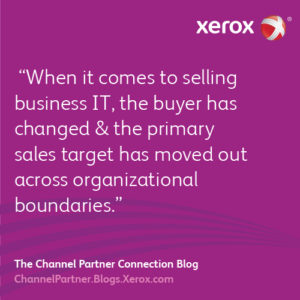
There was a time when a good Rolodex and some solid relationships with CIOs were an IT service provider’s best friends. For almost as long as there has been an IT channel, there’s been a short list of tried-and-true ways to win over the top technology decision maker in most client organizations.
Be concise. Don’t waste their time. Lead with the benefit to them, not to you. Spell their name correctly.
But if the past two years of upheaval and slow recovery in the IT services space have taught us anything, it’s that the old rules barely apply today. When it comes to selling business IT, the buyer has changed and the primary sales target has moved out across organizational boundaries.
Selling speeds and feeds doesn’t cut it
For partners stubbornly fixated on the old points of aim, the message is clear: It’s time to readjust your sights. Where one message based largely on speeds and feeds may have sufficed to win over a technology-focused CIO in the past, business IT services partners will now need a full set of fine-tuned pitches for every stakeholder in the buying cycle, messages that address not only technology features but tangible benefits to the business of marketing, selling, finance and more.
Lines of Business now buying more
Even as business IT continues to grow at around 7 percent annually — from $275.2 billion this year to nearly $331 billion by 2017 — a shift toward a different class of buyers is firmly underway. Overall, businesses account for some 55 percent of total technology spending in the U.S., but traditional enterprise IT spending is only growing at 2 percent annually. The bulk is coming from Line of Businesses (LoBs) newly empowered to acquire technology in pursuit of their own unique business outcomes.
Consider that marketing is now the fastest growing area of business IT spending, growing at close to 10 percent annually over the past five years. The marketing function within the media industry alone is growing its tech spend at 11.2 percent a year. That kind of fragmentation proves that tech spending can no longer be adequately measured at the corporate IT level; technology budgets are being sifted and distributed through LoBs.
Unfortunately, even as the world is changing around them, many partners say they don’t feel ready to move the conversations from technology to business just yet. That needs to change, and fast.
To improve the odds when approaching this new breed of IT buyer, partners should concentrate on four things:
Speak their language
Focus conversations not on technologies, but rather on the business outcomes those technologies drive. Business decision makers today don’t care how the cloud works or what the network is made of, they want to know how technology solutions will address their pain points and improve their performance.
Target vertical markets
As we’ve noted here before, industry-specific sales reap impressive rewards for partners. That’s especially true when it comes to selling to LoB managers in verticals such as healthcare, finance, legal, retail and others. Industry-focused features like HIPAA compliance for health firms or PCI DSS for retailers can go a long way in building a true partnership with such clients. (Read the Vertical Leap series from Connect & Expand.)
Follow the money
In most organizations, IT and the individual LoBs maintain their own budgets. What’s become the case more often than not now is that IT budgets are heavily weighted – sometimes up to 80 percent – toward routine operations or so-called “keeping the lights on” expenses, with little left for innovation or new ventures. LoB budgets tend to invert that ratio, with more funds available for technology improvements. Find out not only who has the power to sign a deal, but also who has the most money available for solutions like the ones you’re offering before you start making your case.
Expand your view
Most partners need to broaden their vision when it comes to identifying just who a LoB manager actually is. Yes, the CFO, the HR director and the VP of marketing are valuable LoB contacts to nurture, but be aware that there are others in the organization – from operations chiefs to distribution and warehouse managers – who have problems to solve and access to funds for IT solutions to help them do it.
We’ve said for some time that the IT solution provider’s true value lies in business services, not in technology. A partner’s ability to speak the language of business — to engage both C-level executives and LoB managers more on process and outcomes and less on tech specs — is at the heart of the services evolution in the channel. IT services partners have long needed a seat at the business table.
That should speak volumes to the new class of tech buyers, the one who are increasingly in control of IT budgets.
Subscribe to the Channel Partner Connection and receive email updates when we publish a new article.
(This article was first published on IT:Connect & Expand, a 2112 Strategy Group blog presented by Xerox for managed service providers.)



